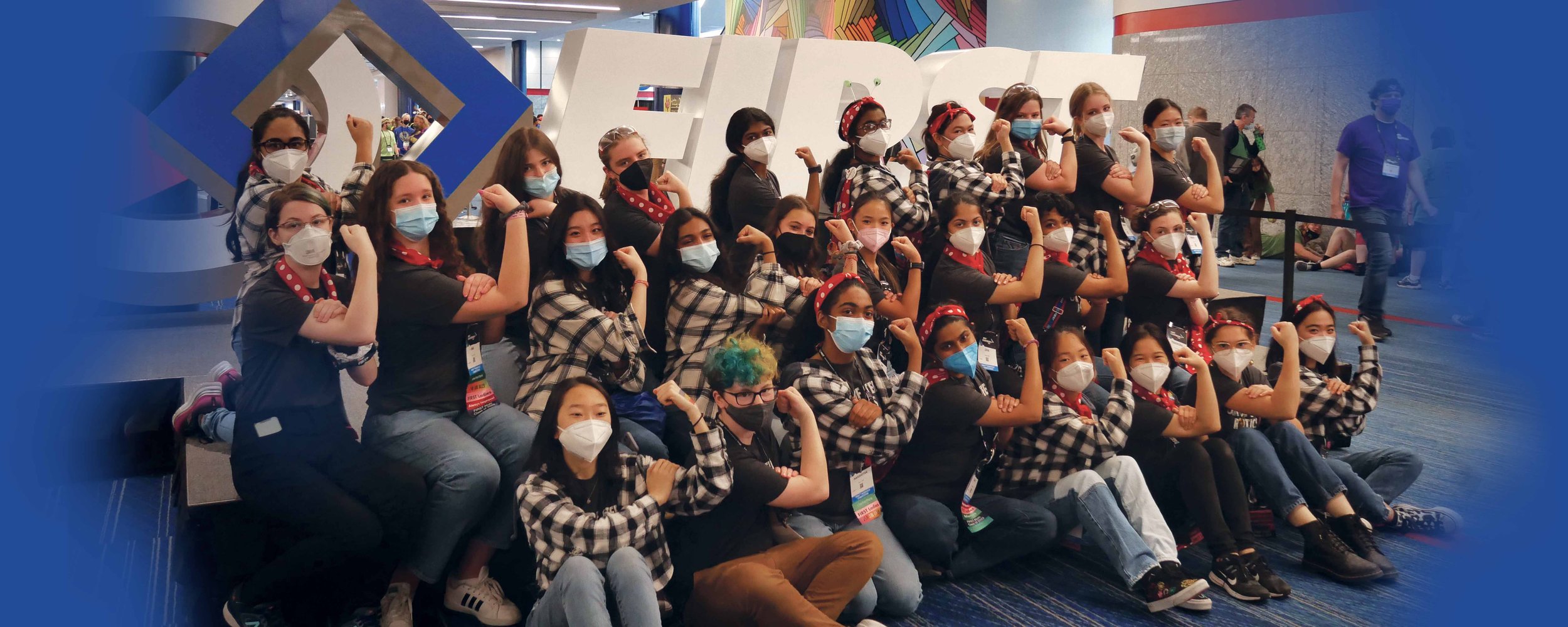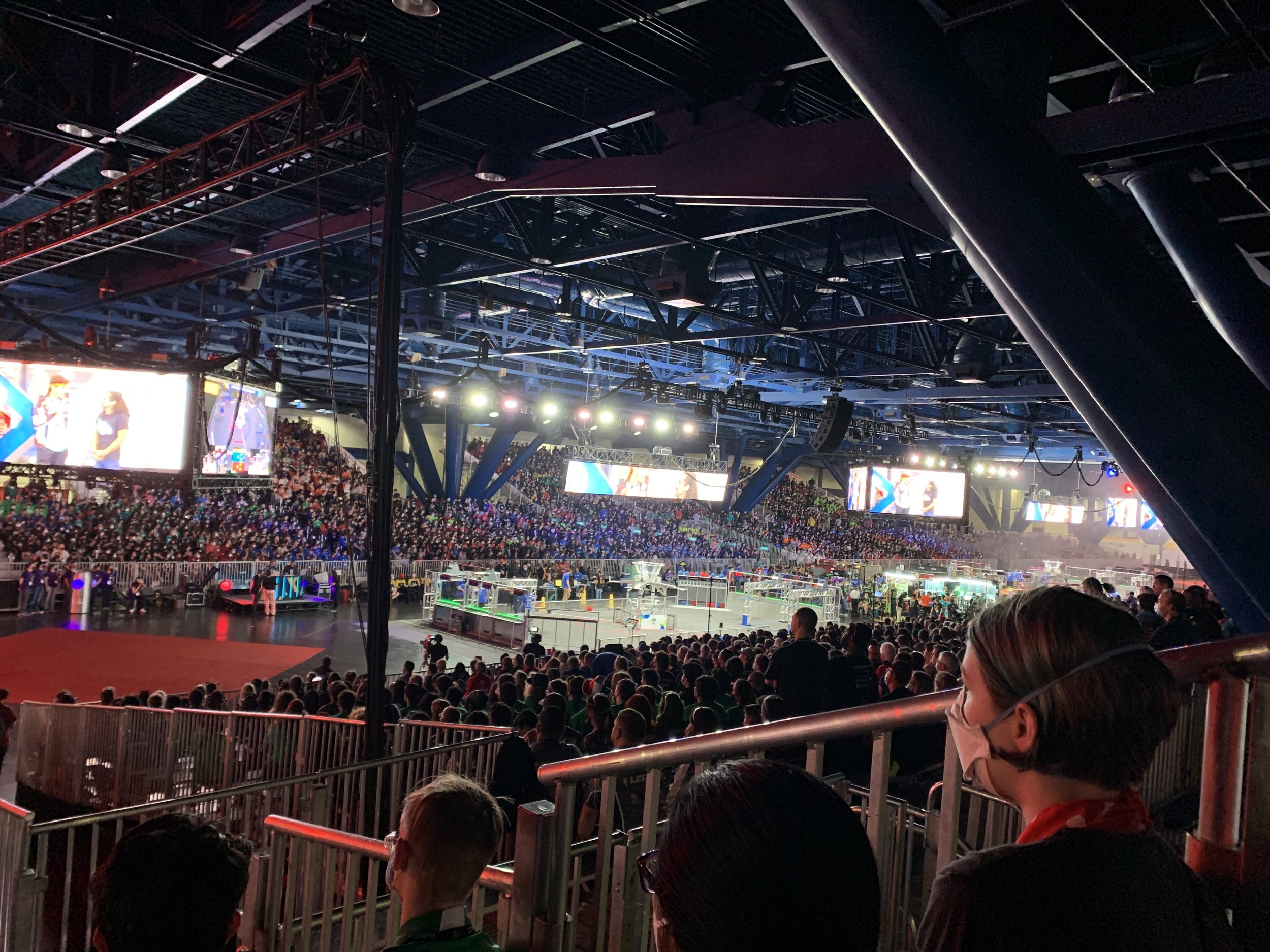
GIRLS OF STEEL GOING GLOBAL
CMU-sponsored Youth Robotics Team Competes in the World Championship
KEVIN O’CONNELL
Six full-length basketball-sized fields of competition stack alongside one another on the floor of the George R. Brown Convention Center in Houston. The packed grandstands teem with fans. The jumbotrons above show highlights of the action on the field while announcers whip the crowd into a frenzy with play-by-play commentary. Flashing lights and blaring music add to the excitement as cheering crowds rise to see the competition heat up across the floor.
It’s a frenetic scene.
This basketball-meets-gymnastics competition set in a rock concert/science fair is the 2022 FIRST Championship — the world championship of youth robotics. Held April 20–23, 2022, it was the first time the championship has happened in three years, due to the Covid pandemic.
Pittsburgh’s Girls of Steel robotics team traveled to Houston to compete against the best of the best in youth robotics, pitting their robot against 600 teams from more than 100 countries. Teams designed, built and programmed their own robots, most of which stood 4-5 feet tall and weighed in at roughly 125 pounds.
The Girls of Steel, sponsored by Carnegie Mellon University, qualified for the world championships by first winning the Engineering Inspirational Award at the Greater Pittsburgh Regional Competition at California University of Pennsylvania. They then double qualified by garnering the Regional Chairman’s Award at the Buckeye Regional Competition in Cleveland as well.
During the championship, teams were divided into six different divisions. The divisions each had 75 teams and were appropriately named after George Washington Carver, Isaac Newton, Galileo Galilei, John A. Roebling, Grace Hopper and Alan Turing. Play consisted of matches between two alliances, red vs. blue, which reformed from match to match. Each alliance consisted of three teams of robots. The robots moved about quickly, scoring points by scooping up balls and shooting them into stacked funnels and then acrobatically climbing and hanging from sturdy bars mounted across theater trusses before time expired. Human team members operated the robots remotely from behind plastic shielding off the field of play.
Lightning McQueen, the Girls of Steel’s robot, performed well — better than the teamed hoped in many instances — as their alliances won five matches and lost five. Though they did not advance to the final rounds of the competition, the girls represented themselves and their technical prowess very well.
“It’s been an amazing experience,” said Sreyashi Mondal, a junior at Pine Richland High School. “I’ve not only had a chance to discover new innovations, but I’ve been able to interact with people from around the world. I’ve learned so much from walking through the pits and speaking to teams about what makes their robot special. I am so grateful to be here.”
A few members of the Girls of Steel team with their robot Lightning McQueen
Lightning McQueen in action, competing in the 2022 FIRST World Robotics Championship at the Houston Convention Center.
“It’s been an amazing experience ... I’ve not only had a chance to discover new innovations, but I’ve been able to interact with people from around the world.”
Meeting teams from around the world is centerpiece of the experience at FIRST, and the Girls of Steel took full advantage. Since the Girls of Steel program has been running for 20 years, several of the adult mentors with the team are alumni of the program and have friends who mentor other teams. The team’s mentors were able to make the rounds and introduce the girls to different people, allowing them to make connections themselves.
“We got to see and compete against the best teams from all over the world,” said George Kantor, professor in the Robotics Institute (RI) and the Girls of Steel’s lead mentor.
By all accounts, the Girls of Steel remain a highly recognizable and popular team at the competition. The team’s mission to empower everyone, especially women and girls, to believe they are capable of success in science, technology, engineering and math resonates strongly with the FIRST organization. Terry Richards, outreach program manager in RI, said, “Our pit was always surrounded by a throng of people wanting to meet our students and learn more about the team. Our team buttons flew off the shelf as fast as we could put them out.”
“They’re inspired for next year,” Kantor said. “The team got a lot of energy, and they’re already working hard to think about what lessons they can take away from this, both from what they did this year and what they learned from talking to and observing other teams.”
Challenges of the Pandemic
Onshape Computer Aided Design software allowed the Girls of Steel to collaborate and continue working on their robot during the pandemic shutdowns. This image is a working design of Lightning McQueen used by the team.
This year’s team faced substantial obstacles to be able to compete at all, much less make it to the world championships. Two years of pandemic shut down everything. When they were able to meet in person in the fall of 2021, heavy restrictions still hampered any potential for progress. Then, when the new year kicked off in 2022, the team was shut down from meeting again by the Omicron variant of Covid.
To overcome this, the team figured out how to do things online and remain effective. As it turned out, programming was one of the easiest activities to move online. To keep from falling behind, the team developed a simulator for their robot so the programmers could develop code and run tests until they could interact with the real robot in person.
The design team also made use of a cloud-based computer aided design (CAD) program called Onshape for remote and simultaneous collaboration. It is kind of like Google Docs but for CAD. Using Onshape, each smaller subsystem team within the greater Girls of Steel team could work on their individual part of Lightning McQueen while also seeing the whole picture of how it was all going to fit and work together. This was key to making good use of time while the team had to work remotely.
“Our pit was always surrounded by a throng of people wanting to meet our students and learn more about the team. Our team buttons flew off the shelf as fast as we could put them out.”

2022 Girls of Steel Team Members
Ciara Anderson
Ariella Avigad
Somdatta Basu
Justine Bennett
Megan Cassady
Elise Chu
Diya Cowlagi
Nina Cranor
Elizabeth Crookston
Maggie Davis
Maeve Dever
Natalie Ficca
Alex George
Susanna Getty
Anuva Ghosalkar
Teadora Gildengers
Grace Goslin
Samhita Gudapati
Katherine Hu
Rayna Huang
Amanda Hulver
Amy Jin
Janise Kim
Jessie Lee
Harshitha Lingam
Kameron Locy
Elizabeth Maier
Mia Maurizio
Lauren Michaels
Sreyashi Mondal
Aria Narasimhan
Madeleine Ng
Swathi Padmanabhan
Dustana Roberts
Mahika Shetty
Rishika Somireddy
Aditi Srivastava
Tara Staresinic
Kelly Tai
Aditri Thakur
Justina Wang
Ashley Wei
Gloria Wen
Hannah Yang
Mary Zagrocki
They spent a lot of time on Zoom as well, talking and addressing the little details that often fall through the cracks, like ordering the right parts and making sure they had the right tools, so that when they were ready to build, they weren’t missing something vital. Time was going to be tight, but when they were able to meet in person, the team’s organization and innovative efforts paid off. They had everything lined up and procured everything they needed, allowing them to be incredibly efficient putting it all together. “It goes without saying that I’m ridiculously proud of this group of students. I’m always proud of the students, but the challenges they had to overcome this year were daunting,” Kantor said.
Harshitha Lingam, a sophomore at South Fayette High School, thoroughly enjoyed her first experience competing in the world championship. “It was such a cool experience being able to see and interact with teams from all over the world and get to know them outside of just robotics! It truly was so awesome to see all of our hard work over the season come to fruition.” ■




